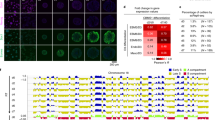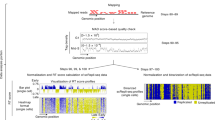Abstract
DNA rearrangements such as sister chromatid exchanges (SCEs) are sensitive indicators of genomic stress and instability, but they are typically masked by single-cell sequencing techniques. We developed Strand-seq to independently sequence parental DNA template strands from single cells, making it possible to map SCEs at orders-of-magnitude greater resolution than was previously possible. On average, murine embryonic stem (mES) cells exhibit eight SCEs, which are detected at a resolution of up to 23 bp. Strikingly, Strand-seq of 62 single mES cells predicts that the mm9 mouse reference genome assembly contains at least 17 incorrectly oriented segments totaling nearly 1% of the genome. These misoriented contigs and fragments have persisted through several iterations of the mouse reference genome and have been difficult to detect using conventional sequencing techniques. The ability to map SCE events at high resolution and fine-tune reference genomes by Strand-seq dramatically expands the scope of single-cell sequencing.
This is a preview of subscription content, access via your institution
Access options
Subscribe to this journal
Receive 12 print issues and online access
$259.00 per year
only $21.58 per issue
Buy this article
- Purchase on Springer Link
- Instant access to full article PDF
Prices may be subject to local taxes which are calculated during checkout



Similar content being viewed by others
Accession codes
References
Bishop, A.J. & Schiestl, R.H. Homologous recombination and its role in carcinogenesis. J. Biomed. Biotechnol. 2, 75–85 (2002).
Greaves, M. & Maley, C.C. Clonal evolution in cancer. Nature 481, 306–313 (2012).
Navin, N. et al. Tumour evolution inferred by single-cell sequencing. Nature 472, 90–94 (2011).
Aguilera, A. & Gomez-Gonzalez, B. Genome instability: a mechanistic view of its causes and consequences. Nat. Rev. Genet. 9, 204–217 (2008).
Wilson, D.M. III. & Thompson, L.H. Molecular mechanisms of sister-chromatid exchange. Mutat. Res. 616, 11–23 (2007).
Wu, L. Role of the BLM helicase in replication fork management. DNA Repair (Amst.) 6, 936–944 (2007).
Kato, H. Spontaneous sister chromatid exchanges detected by a BUdR-labelling method. Nature 251, 70–72 (1974).
Allen, J.W. & Latt, S.A. Analysis of sister chromatid exchange formation in vivo in mouse spermatogonia as a new test system for environmental mutagens. Nature 260, 449–451 (1976).
Falconer, E. et al. Identification of sister chromatids by DNA template strand sequences. Nature 463, 93–97 (2010).
Sakaue-Sawano, A. et al. Visualizing spatiotemporal dynamics of multicellular cell-cycle progression. Cell 132, 487–498 (2008).
Vassilev, L.T. et al. Selective small-molecule inhibitor reveals critical mitotic functions of human CDK1. Proc. Natl. Acad. Sci. USA 103, 10660–10665 (2006).
Helleday, T. Pathways for mitotic homologous recombination in mammalian cells. Mutat. Res. 532, 103–115 (2003).
Yang, H., Chen, X. & Wong, W.H. Completely phased genome sequencing through chromosome sorting. Proc. Natl. Acad. Sci. USA 108, 12–17 (2011).
Fan, H.C., Wang, J., Potanina, A. & Quake, S.R. Whole-genome molecular haplotyping of single cells. Nat. Biotechnol. 29, 51–57 (2011).
Tateishi, S. et al. Enhanced genomic instability and defective postreplication repair in RAD18 knockout mouse embryonic stem cells. Mol. Cell. Biol. 23, 474–481 (2003).
Jaco, I., Canela, A., Vera, E. & Blasco, M.A. Centromere mitotic recombination in mammalian cells. J. Cell Biol. 181, 885–892 (2008).
Trask, B.J. et al. Studies of metaphase and interphase chromosomes using fluorescence in situ hybridization. Cold Spring Harb. Symp. Quant. Biol. 58, 767–775 (1993).
Rebuzzini, P. et al. Karyotype analysis of the euploid cell population of a mouse embryonic stem cell line revealed a high incidence of chromosome abnormalities that varied during culture. Cytogenet. Genome Res. 121, 18–24 (2008).
Liang, Q., Conte, N., Skarnes, W.C. & Bradley, A. Extensive genomic copy number variation in embryonic stem cells. Proc. Natl. Acad. Sci. USA 105, 17453–17456 (2008).
Kalisky, T. & Quake, S.R. Single-cell genomics. Nat. Methods 8, 311–314 (2011).
Cox, A. et al. A new standard genetic map for the laboratory mouse. Genetics 182, 1335–1344 (2009).
Armakolas, A. & Klar, A.J. Cell type regulates selective segregation of mouse chromosome 7 DNA strands in mitosis. Science 311, 1146–1149 (2006).
Rocheteau, P., Gayraud-Morel, B., Siegl-Cachedenier, I., Blasco, M.A. & Tajbakhsh, S. A subpopulation of adult skeletal muscle stem cells retains all template DNA strands after cell division. Cell 148, 112–125 (2012).
Cairns, J. Somatic stem cells and the kinetics of mutagenesis and carcinogenesis. Proc. Natl. Acad. Sci. USA 99, 10567–10570 (2002).
Lansdorp, P.M. Immortal strands? Give me a break. Cell 129, 1244–1247 (2007).
Kloosterman, W.P. et al. Chromothripsis as a mechanism driving complex de novo structural rearrangements in the germline. Hum. Mol. Genet. 20, 1916–1924 (2011).
Stephens, P.J. et al. Massive genomic rearrangement acquired in a single catastrophic event during cancer development. Cell 144, 27–40 (2011).
Campbell, P.J. et al. Identification of somatically acquired rearrangements in cancer using genome-wide massively parallel paired-end sequencing. Nat. Genet. 40, 722–729 (2008).
Korbel, J.O. et al. Paired-end mapping reveals extensive structural variation in the human genome. Science 318, 420–426 (2007).
Szymczak, A.L. et al. Correction of multi-gene deficiency in vivo using a single 'self-cleaving' 2A peptide-based retroviral vector. Nat. Biotechnol. 22, 589–594 (2004).
Li, H. & Durbin, R. Fast and accurate short read alignment with Burrows-Wheeler transform. Bioinformatics 25, 1754–1760 (2009).
Li, H. et al. The Sequence Alignment/Map format and SAMtools. Bioinformatics 25, 2078–2079 (2009).
Quinlan, A.R. & Hall, I.M. BEDTools: a flexible suite of utilities for comparing genomic features. Bioinformatics 26, 841–842 (2010).
Bezrookove, V. et al. Premature chromosome condensation revisited: a novel chemical approach permits efficient cytogenetic analysis of cancers. Genes Chromosom. Cancer 38, 177–186 (2003).
Acknowledgements
We thank J. Brind'Amour and S. Rentas for discussions and J. Schein and C. Carter (Genome Sciences Centre) for BACs. We also thank K. Gan for help with preliminary MNase experiments. U.N. was supported by a Fellowship for Prospective Researchers from the Swiss National Science Foundation (project no. PBBEP3_131554). Work in the Hirst laboratory is supported by Canadian Institutes of Health Research grant RMF-92093. Work in the Lansdorp laboratory is supported by grants from the Canadian Institutes of Health Research (RMF-92093 and 105265), the US National Institutes of Health (R01GM094146) and the Terry Fox Foundation (018006). P.M.L. is a recipient of an Advanced Grant from the European Research Council.
Author information
Authors and Affiliations
Contributions
E.F. designed experiments, prepared libraries and wrote the paper. M. Hills designed and refined the bioinformatic programs, performed the bioinformatic analysis and helped write the paper. U.N. made Fucci constructs, selected embryonic stem cells for studies and helped with preparation of libraries and writing of the paper. S.S.S.P. designed and wrote the additional bioinformatics programs. E.A.C. performed FISH experiments and cell synchronization and helped with preparation of libraries. A.D.S. helped with preparation of libraries. Y.Z. and M. Hirst participated in experimental design and data analysis. P.M.L. conceived of the study, interpreted results and wrote the paper.
Corresponding author
Ethics declarations
Competing interests
The authors declare no competing financial interests.
Supplementary information
Supplementary Text and Figures
Supplementary Figures 1–14 and Supplementary Tables 1 and 2 (PDF 1739 kb)
Supplementary Data
This PDF document provides chromosome ideograms and coverage statistics for four whole-genome shotgun (WGS) libraries and 62 Strand-seq libraries. The first two pages provide a summary table (pages 1–2) that lists all single-cell libraries, with clickable links to the ideograms. The table also summarizes library information such as cell input, synchronization and BrdU/Hoechst/UV treatment as well as coverage statistics including percent genomic coverage, the number of unique reads with a mapping quality score of at least 20 (q20, see Online Methods) and a summary of the number of observed chromosomes with SCEs or aneuploidy. Each library is presented on a single page (pages 3–68) with Watson and Crick reads mapped on chromosome ideograms (see main manuscript). The ideograms are the output of our bioinformatic analysis of inherited templates (BAIT) analysis pipeline (see Online Methods). The information from the summary table appears for each library. The average reads per megabase for both Watson and Crick reads appears below each chromosome in orange and blue numbers, respectively. Aneuploid chromosomes are identified with 'monosomy' or 'trisomy' written below the chromosome ideogram, with the percentage indicating the proportion of reads compared to the average genomic read depth. The overall reads per megabase for the entire genome is found in the bottom right of each page. Because the length of the horizontal orange and blue lines projecting from the chromosome ideograms represents the total number of reads per 200-kb bin (see main manuscript), the library ideograms were scaled to prevent high coverage libraries from overlapping between adjacent chromosomes (scale factor). (PDF 13316 kb)
Rights and permissions
About this article
Cite this article
Falconer, E., Hills, M., Naumann, U. et al. DNA template strand sequencing of single-cells maps genomic rearrangements at high resolution. Nat Methods 9, 1107–1112 (2012). https://doi.org/10.1038/nmeth.2206
Received:
Accepted:
Published:
Issue Date:
DOI: https://doi.org/10.1038/nmeth.2206
This article is cited by
-
The variation and evolution of complete human centromeres
Nature (2024)
-
A non-genetic switch triggers alternative telomere lengthening and cellular immortalization in ATRX deficient cells
Nature Communications (2023)
-
Single-cell multi-omics allows functional characterization of structural variants
Nature Biotechnology (2023)
-
Unintended CRISPR-Cas9 editing outcomes: a review of the detection and prevalence of structural variants generated by gene-editing in human cells
Human Genetics (2023)
-
Combining callers improves the detection of copy number variants from whole-genome sequencing
European Journal of Human Genetics (2022)



